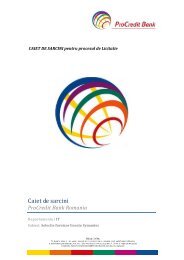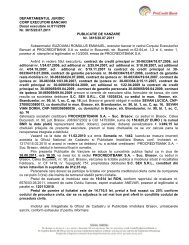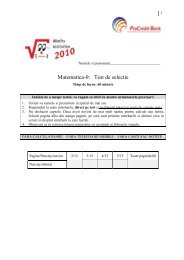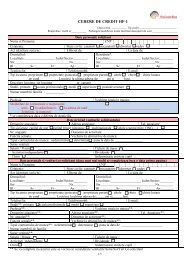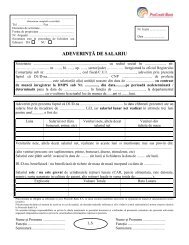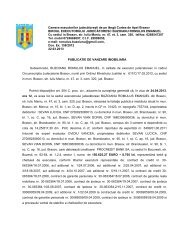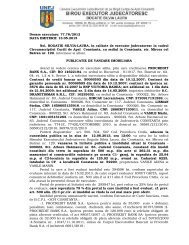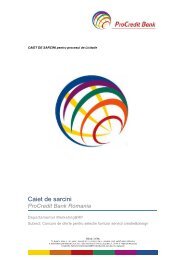Annual Report 2010 - ProCredit Bank
Annual Report 2010 - ProCredit Bank
Annual Report 2010 - ProCredit Bank
Create successful ePaper yourself
Turn your PDF publications into a flip-book with our unique Google optimized e-Paper software.
54<br />
<strong>Annual</strong> <strong>Report</strong> <strong>2010</strong><br />
h) Financial assets and liabilities<br />
i. Classification<br />
The <strong>Bank</strong> classifies its financial instruments in the following categories:<br />
Financial assets or financial liabilities at fair value through profit<br />
or loss. This category has two sub-categories: financial assets or<br />
financial liabilities held for trading, and those designated at fair<br />
value through profit or loss at inception. A financial instrument is<br />
classified in this category if it is:<br />
(i) acquired or incurred principally for the purpose of selling or<br />
repurchasing it in the near term;<br />
(ii) part of a portfolio of identified financial instruments that are<br />
managed together and for which there is evidence of a recent<br />
actual pattern of short-term profit-taking; or<br />
(iii) a derivative (except for a derivative that is a financial guarantee<br />
contract or a designated and effective hedging instrument).<br />
Loans and receivables are non-derivative financial assets with fixed<br />
or determinable payments that are not quoted in an active market,<br />
other than those that the <strong>Bank</strong> intends to sell immediately or in<br />
the near term, those that the <strong>Bank</strong>, upon initial recognition, designates<br />
as at fair value through profit and loss, those that the <strong>Bank</strong>,<br />
upon initial recognition, designates as available for sale or those<br />
for which the holder may not recover substantially all of its initial<br />
investment, other than because of credit deterioration. Loans and<br />
advances comprise loans and advances to banks and customers.<br />
Held-to-maturity investments are non-derivative financial assets<br />
with fixed or determinable payments and fixed maturities that the<br />
<strong>Bank</strong>’s management has the positive intention and ability to hold<br />
to maturity.<br />
Available-for-sale financial assets are those financial assets that<br />
are designated as available for sale or are not classified as loans<br />
and advances, held-to-maturity investments or financial assets at<br />
fair value through profit or loss.<br />
ii. Recognition<br />
The <strong>Bank</strong> initially recognises loans and advances, deposits, debt<br />
securities issued and subordinated liabilities on the date that they<br />
are originated. All other financial assets and liabilities (including<br />
assets and liabilities designated at fair value through profit or<br />
loss) are initially recognised on the trade date at which the <strong>Bank</strong><br />
becomes a party to the contractual provisions of the instrument.<br />
iii. Derecognition<br />
The <strong>Bank</strong> derecognises a financial asset when the contractual<br />
rights to the cash flows from the asset expire, or it transfers the<br />
rights to receive the contractual cash flows on the financial asset<br />
in a transaction in which substantially all the risks and rewards of<br />
ownership of the financial asset are transferred. Any interest in<br />
transferred financial assets that is created or retained by the <strong>Bank</strong><br />
is recognised as a separate asset or liability. The <strong>Bank</strong> writes off<br />
the loans and advances to customers when they are determined to<br />
be uncollectible.<br />
The <strong>Bank</strong> derecognises a financial liability when its contractual obligations<br />
are discharged or cancelled or expire.<br />
iv. Offsetting<br />
Financial assets and liabilities are set off and the net amount presented<br />
in the balance sheet when, and only when, the <strong>Bank</strong> has a<br />
legal right to set off the amounts and intends either to settle on a net<br />
basis or to realise the asset and settle the liability simultaneously.<br />
Income and expenses are presented on a net basis only when permitted<br />
by the accounting standards, or for gains and losses arising from<br />
a group of similar transactions such as in the <strong>Bank</strong>’s trading activity.<br />
v. Amortised cost measurement<br />
The amortised cost of a financial asset or liability is the amount at<br />
which the financial asset or liability is measured at initial recognition,<br />
minus principal repayments, plus or minus the cumulative<br />
amortisation using the effective interest method of any difference<br />
between the initial amount recognised and the maturity amount,<br />
minus any reduction for impairment.<br />
vi. Fair value measurement<br />
Fair value is the amount for which an asset could be exchanged,<br />
or a liability settled, between knowledgeable, willing parties in<br />
an arm’s length transaction on the measurement date. The determination<br />
of fair values of financial assets and financial liabilities<br />
is based on quoted market prices or dealer price quotations for financial<br />
instruments traded in active markets. A market is regarded<br />
as active if quoted prices are readily and regularly available and<br />
represent actual and regularly occurring market transactions on an<br />
arm’s length basis. For all other financial instruments fair value is<br />
determined by using valuation techniques. Valuation techniques<br />
include net present value techniques, the discounted cash flow<br />
method, comparison to similar instruments for which market observable<br />
prices exist, and valuation models.<br />
The chosen valuation technique makes maximum use of market inputs,<br />
relies as little as possible on estimates specific to the <strong>Bank</strong>,<br />
incorporates all available factors that market participants would<br />
consider in setting a price, and is consistent with accepted economic<br />
methodologies for pricing financial instruments. Inputs to<br />
valuation techniques reasonably represent market expectations<br />
and measures of the risk-return factors inherent in the financial<br />
instrument. Where a fair value cannot be reliably estimated, unquoted<br />
equity instruments that do not have a quoted market price<br />
in an active market are measured at cost and periodically tested for<br />
impairment (further described in Note 3h vii).<br />
vii. Identification and measurement of impairment<br />
At each balance sheet date the <strong>Bank</strong> assesses whether there is<br />
objective evidence that financial assets not carried at fair value<br />
through profit or loss are impaired. Financial assets are impaired<br />
when objective evidence demonstrates that a loss event has occurred<br />
after the initial recognition of the asset, and that the loss<br />
event has an impact on the future cash flows on the asset that can<br />
be estimated reliably.<br />
The <strong>Bank</strong> considers evidence of impairment at both a specific asset<br />
and collective level. All individually significant financial assets are<br />
assessed for specific impairment. All significant assets found not<br />
to be specifically impaired are then collectively assessed for any<br />
impairment that has been incurred but not yet identified. Assets<br />
that are not individually significant are then collectively assessed<br />
for impairment by grouping together financial assets (carried at<br />
amortised cost) with similar risk characteristics.<br />
Impairment losses on assets carried at amortised cost are measured<br />
as the difference between the carrying amount of the financial<br />
assets and the present value of estimated cash flows discounted at<br />
the assets’ original effective interest rate. Losses are recognised in<br />
profit or loss and reflected in an allowance account against loans<br />
and advances. Interest on the impaired asset continues to be recognised<br />
through the unwinding of the discount.<br />
Objective evidence that financial assets (including equity securities)<br />
are impaired can include default or delinquency by a borrower,<br />
restructuring of a loan or advance by the <strong>Bank</strong> on terms that the<br />
<strong>Bank</strong> would not otherwise consider, indications that a borrower or<br />
issuer will enter bankruptcy, the disappearance of an active market<br />
for a security, or other observable data relating to a group of assets<br />
such as adverse changes in the payment status of borrowers<br />
or issuers in the group, or economic conditions that correlate with<br />
defaults in the group.




